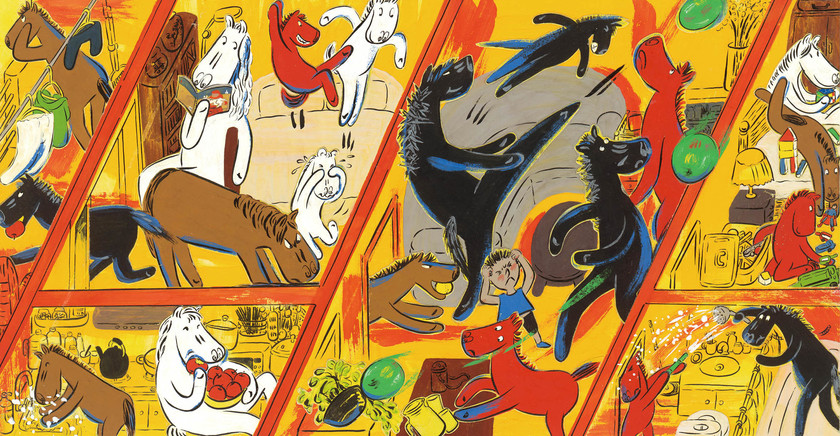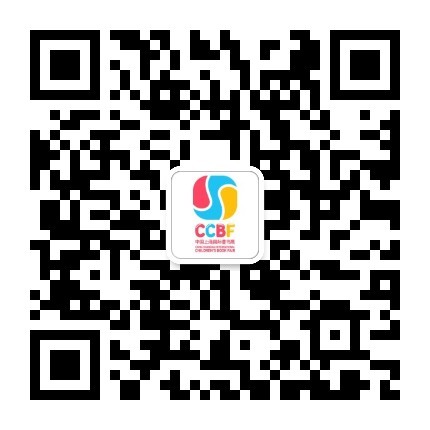China Shanghai International Children's Book Fair has invited picture book artist Huang Li to serve as one of the judges of the 2021 Golden Pinwheel Young Illustrators Competition. Huang Li is an illustrator and the director of Xi'an TaiYangWa Design studio. Switching constantly from one role to the other does not wear her out. Instead, it helps her open to new insights on her job and the market. We had a lively one-on-one conversation with her about picture books and her hopes for emerging illustrators.
Huang Li in creation
Q=China Shanghai International Children's Book Fair(CCBF) A=Huang Li
Q:You are a picture book artist and director of a design company. What do you think of the recent development of illustration in China? Do you have any advice for young illustrators who wish to start making picture books?
A:China started publishing foreign picture books about 20 years ago. This was key in making us realise how important picture books are to children's development and reading. It has also encouraged a growing number of artists to dabble in children's illustration. So we can say it is the readers' demand that has accelerated the development of the local illustration scene in recent years.
Children's reading is strongly advocated and promoted at both government and society levels. Many art universities have opened picture book and illustration degrees and courses. Chinese publishers are increasingly committed to publishing original picture books. Picture book awards are flourishing around the country and more and more training opportunities are offered. All this has improved considerably the microcosm of the illustration industry.
As enthusiastic and full of ideas as we illustrators are, one’s ability to create good art cannot be achieved overnight. Picture book is a comprehensive art that covers literature, aesthetics, education, children’s psychology, reading, among other things. So, my advice to young illustrators is to have a sense of awe, be demanding of oneself and one’s professional objectives, and never stop exploring new ways to create books suitable for children.
Q:As a picture book illustrator, how do you approach a new project? How do you look on your own work?
A:Picture books are a specific genre within children's literature, whose particularity comes from its readers. Young children can't read or recognise every written sign, and picture books are often their first reading experience shared with an adult. Parents read with their children, who hear the words told by adults while they see the pictures. Pictures and words blend in their mind to form a whole story. This reading approach—picture books = text x pictures—is unique. Words intertwine with pictures, which are often co-created by a writer and an illustrator.
This unique art form has fascinated me and pushed me to become a picture book illustrator more than a decade ago.
How to make illustrations for a picture book? Is it just about making vivid and colourful pictures or about delivering writers’ stories with unerring accuracy? Neither, I think, is the right answer. To illustrate a picture book, the first thing is to understand children.
To know children means to understand their internal development, the way they perceive things, the way they feel happiness, distress and confusion. In a theory put forward by Jean Piaget—a Swiss psychologist known for his work on children development—children are seen as “builders": they are active and curious explorers of their knowledge. When they come across new ideas that challenge their prior knowledge, they have to accommodate these ideas to modify their existing understanding and form a new one. In a good picture book, the text and visual language are meticulously designed to create an emotional channel for children to perceive and construct their own knowledge of the story. I keep in mind that children are builders when I illustrate. I consciously think about how to show all the implications of the story, how to build an appropriate emotional channel through pictures, and guide them to complete their mental construction.
When drawing for children, the second thing to pay attention to is the emotional connection.
Children are at the peak period of sensory integration, and their knowledge of things is primarily obtained by sensorial perception. Although they can’t really read yet, they can “read” pictures and feel the joy, beauty, sadness or ugliness conveyed in them. Whether the story is told in a smooth and fluid way, whether the emotions contained in the pictures are clear, whether the details of the pictures trigger curiosity, how the pictures complement the text, and how the chosen art technique conforms to the story's tone… all this will determine whether a child understands and can be moved by a picture book. Therefore, illustrating for children requires a great deal of attention, not only to the story-telling, but also all the details that make the book unique, such as emotional transformations, details of the picture, selection of media, etc. The emotions conveyed by the pictures is a bridge to children's heart.
In picture book creation, illustrators often need to cooperate with writers to tell a story. However, illustrators should always bear this in mind that pictures are by no means subordinate to the text. Instead, text and images are intricately complementary.
Illustrators have their own understanding of the story, as well as their own understanding of life. Living your life heartfully and taking full measure of human nature and society should be the starting point of all creation, a creation that will allow young readers resonate with you through the story. For example, when I was working on Grandma's Horses, my strong creative desire came from my own childhood experience with my grandmother. I poured my own feelings into the book so that readers could "see" love and companionship in the story.
Regardless of the theme, content and form of children’s illustration, I also try to capture the essence of our own culture and express China’s distinctive philosophical and cultural beliefs.
When I was working on Ann’s Seeds, I took Laozi's "Way of Nature" as a starting point for my creative work and bear in mind a principle I inherited from my personal life and emotional experience—"even the most splendid things return to dullness”. Regarding the technique, I used a colouring method similar to those used in Chinese traditional mural painting and chose a beige pigment called “Dunhuang soil”, which echoes well with the dry, unadorned and quiet theme of the story. Since its publication ten years ago, the book has struck a chord with countless readers for its rich cultural features and philosophical reflections.
In China, original picture book creation started less than 20 years ago. Unfortunately, there was no clear direction to lead the process. Every writer, every illustrator was exploring without footprints. From 2003, I became one of the early and lucky explorers of this art. Ann’s Seeds and Grandma’s Horses result from those many years of experiments, attempts and explorations. I am now convinced that understanding children, and be emotionally and culturally truthful to one’s reality is the path to making good books.
Q: The styles of your two books are quite different. Ann’s Seeds uses Chinese traditional painting colour palette, while Grandma's Horses adopts a simpler yet vibrant style. What determined this change? What is the influence of traditional Chinese art techniques on your work?
A:I always try to choose a visual language that is suitable to each story. For example, Ann's Seeds tells a story about the wait for flowers to bloom. For me, waiting involves calmness and peace. Therefore, I tried to capture the feeling of silence. Ann's Seeds was published twelve years ago and is loved by many readers. The most popular comment on the Internet is: "This is a book with a quiet and calm vibe!" "After reading this book, my heart calms down." Of course, the story itself induces serenity, but with the adequate visual language emotions can be even more contagious!
Compared with Ann's Seeds, Grandma's Horses is a rather cheerful piece of work. It tells the story of Little Thing (Xiaodongxi), a little boy who immerses himself in an imaginary world during his summer holidays at his grandma’s. In the story, the grandmother’s daily routine intertwines with Little Thing’s imagination. When I first read the story, what I heard was small talks between Little Thing and his grandmother, but what actually flashed in my head was Little Thing's horse inviting himself to grandmother's for a visit. At that moment, I understood that the pictures for this book should not be a linear narration of the text, page after page, but should be the interweaving of real-life and the imaginary world. Thus, a combination of virtuality and reality is the best way to showcase this book.

Grandma's Horses
So, how to use visual languages to show the virtuality and reality of the story? Grandma's daily life is simple and ordinary, which I depicted using ink and light colours. At the same time, I chose to represent the children’s wild imagination through a rich and joyful pictorial language.
I graduated in Chinese painting and, although my two books show different styles, I used in both traditional Chinese painting materials and concepts, to which I added a twist of Western expressionism to convey more emotions. Generally speaking, the two books have the same illustrative concept—telling a story through Chinese painting language and using suitable composition and colours based on the emotions the stories intend to transmit.
In many readers have feedback I hear they feel a sense of intimacy in my work. This is probably due to the use of traditional Chinese painting, which gives my visual language a "local accent" that talks to my Chinese readers.
Q:What are your expectations regarding your upcoming participation in the Golden Pinwheel Jury?
A: I really look forward to it. I will get to see the works of very different illustrators from all over the world. For me, it is a beautiful journey to broaden my horizons, to learn and get inspired.
I also hope to find excellent works through the joint effort all the jurors put in the review sessions, and these works will be seen by more readers.
Q:Your company carried out children's art education projects and brought the courses to school. What picture books did you recommend for the kids?
A: We have created and conducted art courses in schools for 8 years now. Currently there are three primary schools—that is more than 5,000 children—using our educational services. Students, teachers, parents and schools all give us great feedback. After a few years of research and exploration, we have managed to provide our art teachers with qualified training for those art curriculums. We choose the best picture books according to the children’s age groups and intellectual development. The Chinese picture books we recommend to our students include The Early Market in Hehua Town; Teeth, Teeth; Throwing Them onto Roofs; The Most Terrible Day; Reunion; Ann’s Seeds; Obsessed with Opera, among others.
Art education aims to develop and improve personality, and picture books share the same value and meaning. So, it’s safe to say quality picture books are an essential teaching resource for art education courses.





